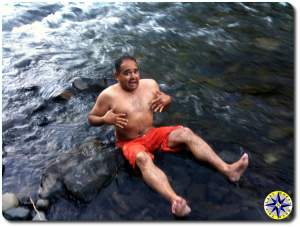 Check out off-road adventure photos and you’ll find 4×4 trucks splashing through the water, creating giant walls of H2O that make you believe you are witness to the parting of the Red Sea. Yes we’re guilty of getting caught up in the moment, throwing caution to the wind and racing through a wet patch for a good photo… We could hurt ourselves… for your entertainment.
Check out off-road adventure photos and you’ll find 4×4 trucks splashing through the water, creating giant walls of H2O that make you believe you are witness to the parting of the Red Sea. Yes we’re guilty of getting caught up in the moment, throwing caution to the wind and racing through a wet patch for a good photo… We could hurt ourselves… for your entertainment.
But experience says the best course of action is be cautious when it comes to Water crossings.
In the Northwest winter off-road means water and lots of it. But you can find trails that require water fording just about anywhere depending on the time of year… Even the deserts of Baja has its water crossings. So how do you prepare for a swim.
A water crossing can be fatal to an engine or even worse to occupants of the vehicle if everything goes south. Never underestimate the force of flowing water. Water weighs in at about 62.4 pounds per cubic foot and for each foot the water flowing against a vehicle there can be 500 pounds of lateral force pushing against your rig.
Sure you can install a snorkel, relocate you differential breather and try to make your rig water proof. But in the end you cannot make an off-road adventure truck as water tight as a frogs ass. So want is a guy to do when you have to get to the other side.
The first and most important thing to do when coming up to a water crossing is to know what you’re in for.
- How deep is the water? Is it deeper than your air intake? How about your spark plugs or alternator?
- Is the water just sitting there or flowing swiftly?
- What is the bottom like? Can you see the bottom? Is it a mine field of boulders and tree branches? Is it soft, sink to your axles muck? Are their any deep holes that could swallow your rig?
If you come up to a water crossing and don’t know the answers to these questions… Stop, get out and look. Roll up your pants and walk through the water… grab your shovel, a wadding staff or stick, and poke at the bottom to feel what your tires will be grabbing. Don’t be misled by what appears to be a shallow stretch of water, which is hiding a foot of deep stinky muck that will have you stuck, axle deep in a mud that refuses to release it’s grip.
Don’t forget to check out what the other side is like? Will you have to try to drive up a steep muddy high bank or is it a soft sandy exit? Look around for tire tracks to see if others have made it through… look for where they went in and where they came out.
While you’re scouting the water crossing, plan for any miss haps. Are there recovery points to winch off if need? If you’re traveling with other rigs are they prepared to get you unstuck in case you don’t make it? Have a plan, just in case.
Driving through water is enough of an adrenaline rush without stomping on the skinny peddle. By driving slow and steady your rig will create a bow wave in front of your rig, which creates and keeps a pocket of shallower water behind it where your rig is traveling. This bow wave allows you to drive through water that might otherwise exceed your rigs crossing depth capability. Of course if you loose that steady momentum, you loose that pocket and can quickly find your rig hydrolocked in the middle of a river.
To cross water enter at the slow steady pace you will maintain throughout the crossing. Hold your momentum and keep your splashing to a minimum. Avoid bouncing around or quickly changing direction which can cause you to loose your bow wave. Follow through on your exit continuing your progress until your rig is high and dry.
If your facing a particularly deep water crossing, you can increase your rig’s ability to create a bow wave by duct taping plastic or a plank of wood across the front grill. But if you’re considering how to exceed your rig’s capabilities for water fording, you may want to starting looking for another route across.
Water crossings are part of overlanding and is often what separates an off-road adventure from a mini-van road trip. If you know your rigs capabilities. scout the crossing and motor through cautiously you’ll be able to go further down the road less traveled on your off-road adventures.

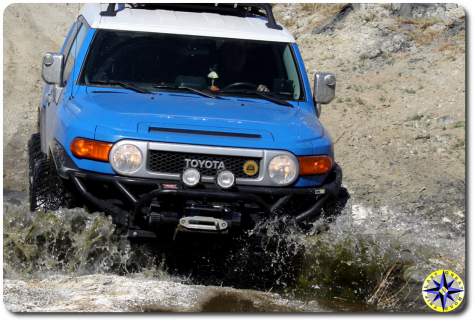
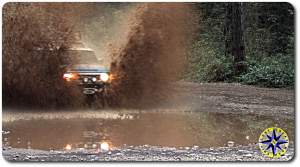
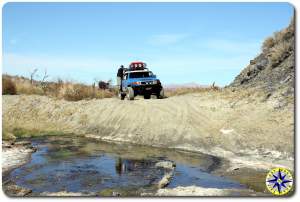
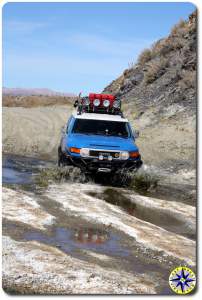
Great article. I’m very familiar with the term “hydrolocked”. Not fun. Bent connecting rods and other costly damage can come from not thinking a water crossing through. For me, it was simply peer pressure after watching other guys go through a hole that was too much for me. I should’ve known. Now I do, learn from my mistake.
Ouch… thanks for sharing. Hopefully everyone will take that to heart next time they’re staring down a water crossing.